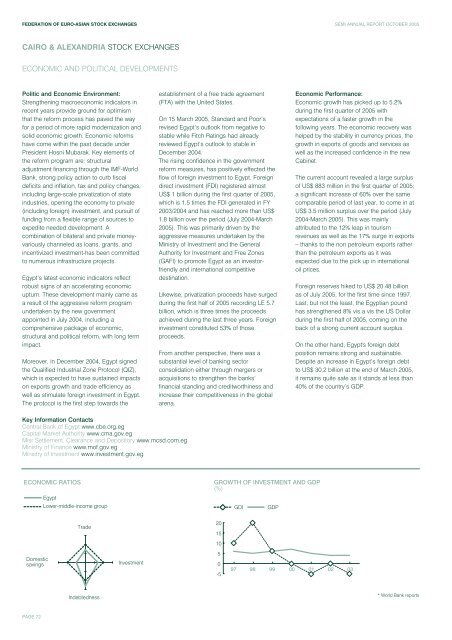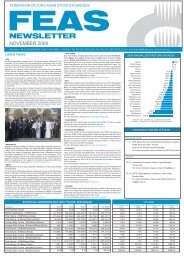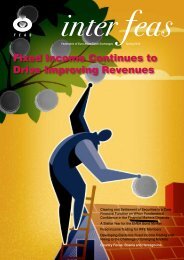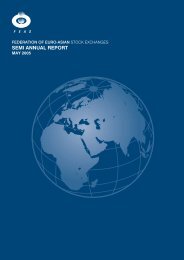Download - FEAS
Download - FEAS
Download - FEAS
You also want an ePaper? Increase the reach of your titles
YUMPU automatically turns print PDFs into web optimized ePapers that Google loves.
FEDERATION OF EURO-ASIAN STOCK EXCHANGES SEMI ANNUAL REPORT OCTOBER 2005<br />
CAIRO & ALEXANDRIA STOCK EXCHANGES<br />
ECONOMIC AND POLITICAL DEVELOPMENTS<br />
Politic and Economic Environment:<br />
Strengthening macroeconomic indicators in<br />
recent years provide ground for optimism<br />
that the reform process has paved the way<br />
for a period of more rapid modernization and<br />
solid economic growth. Economic reforms<br />
have come within the past decade under<br />
President Hosni Mubarak. Key elements of<br />
the reform program are: structural<br />
adjustment financing through the IMF-World<br />
Bank, strong policy action to curb fiscal<br />
deficits and inflation, tax and policy changes,<br />
including large-scale privatization of state<br />
industries, opening the economy to private<br />
(including foreign) investment, and pursuit of<br />
funding from a flexible range of sources to<br />
expedite needed development. A<br />
combination of bilateral and private moneyvariously<br />
channeled as loans, grants, and<br />
incentivized investment-has been committed<br />
to numerous infrastructure projects.<br />
Egypt’s latest economic indicators reflect<br />
robust signs of an accelerating economic<br />
upturn. These development mainly came as<br />
a result of the aggressive reform program<br />
undertaken by the new government<br />
appointed in July 2004, including a<br />
comprehensive package of economic,<br />
structural and political reform, with long term<br />
impact.<br />
Moreover, in December 2004, Egypt signed<br />
the Qualified Industrial Zone Protocol (QIZ),<br />
which is expected to have sustained impacts<br />
on exports growth and trade efficiency as<br />
well as stimulate foreign investment in Egypt.<br />
The protocol is the first step towards the<br />
Key Information Contacts<br />
Central Bank of Egypt www.cbe.org.eg<br />
Capital Market Authority www.cma.gov.eg<br />
Misr Settlement, Clearance and Depository www.mcsd.com.eg<br />
Ministry of Finance www.mof.gov.eg<br />
Ministry of Investment www.investment.gov.eg<br />
ECONOMIC RATIOS<br />
Domestic<br />
savings<br />
PAGE 72<br />
Egypt<br />
Lower-middle-income group<br />
Trade<br />
Indebtedness<br />
Investment<br />
establishment of a free trade agreement<br />
(FTA) with the United States.<br />
On 15 March 2005, Standard and Poor’s<br />
revised Egypt’s outlook from negative to<br />
stable while Fitch Ratings had already<br />
reviewed Egypt’s outlook to stable in<br />
December 2004.<br />
The rising confidence in the government<br />
reform measures, has positively effected the<br />
flow of foreign investment to Egypt. Foreign<br />
direct investment (FDI) registered almost<br />
US$ 1 billion during the first quarter of 2005,<br />
which is 1.5 times the FDI generated in FY<br />
2003/2004 and has reached more than US$<br />
1.8 billion over the period (July 2004-March<br />
2005). This was primarily driven by the<br />
aggressive measures undertaken by the<br />
Ministry of Investment and the General<br />
Authority for Investment and Free Zones<br />
(GAFI) to promote Egypt as an investorfriendly<br />
and international competitive<br />
destination.<br />
Likewise, privatization proceeds have surged<br />
during the first half of 2005 recording LE 5.7<br />
billion, which is three times the proceeds<br />
achieved during the last three years. Foreign<br />
investment constituted 53% of those<br />
proceeds.<br />
From another perspective, there was a<br />
substantial level of banking sector<br />
consolidation either through mergers or<br />
acquisitions to strengthen the banks’<br />
financial standing and creditworthiness and<br />
increase their competitiveness in the global<br />
arena.<br />
GROWTH OF INVESTMENT AND GDP<br />
(%)<br />
20<br />
15<br />
10<br />
5<br />
0<br />
-5<br />
97<br />
GDI GDP<br />
Economic Performance:<br />
Economic growth has picked up to 5.2%<br />
during the first quarter of 2005 with<br />
expectations of a faster growth in the<br />
following years. The economic recovery was<br />
helped by the stability in currency prices, the<br />
growth in exports of goods and services as<br />
well as the increased confidence in the new<br />
Cabinet.<br />
The current account revealed a large surplus<br />
of US$ 883 million in the first quarter of 2005;<br />
a significant increase of 60% over the same<br />
comparable period of last year, to come in at<br />
US$ 3.5 million surplus over the period (July<br />
2004-March 2005). This was mainly<br />
attributed to the 12% leap in tourism<br />
revenues as well as the 17% surge in exports<br />
– thanks to the non petroleum exports rather<br />
than the petroleum exports as it was<br />
expected due to the pick up in international<br />
oil prices.<br />
Foreign reserves hiked to US$ 20.48 billion<br />
as of July 2005, for the first time since 1997.<br />
Last, but not the least, the Egyptian pound<br />
has strengthened 8% vis a vis the US Dollar<br />
during the first half of 2005, coming on the<br />
back of a strong current account surplus.<br />
On the other hand, Egypt's foreign debt<br />
position remains strong and sustainable.<br />
Despite an increase in Egypt’s foreign debt<br />
to US$ 30.2 billion at the end of March 2005,<br />
it remains quite safe as it stands at less than<br />
40% of the country’s GDP.<br />
98 99 00 01 02 03<br />
* World Bank reports
















